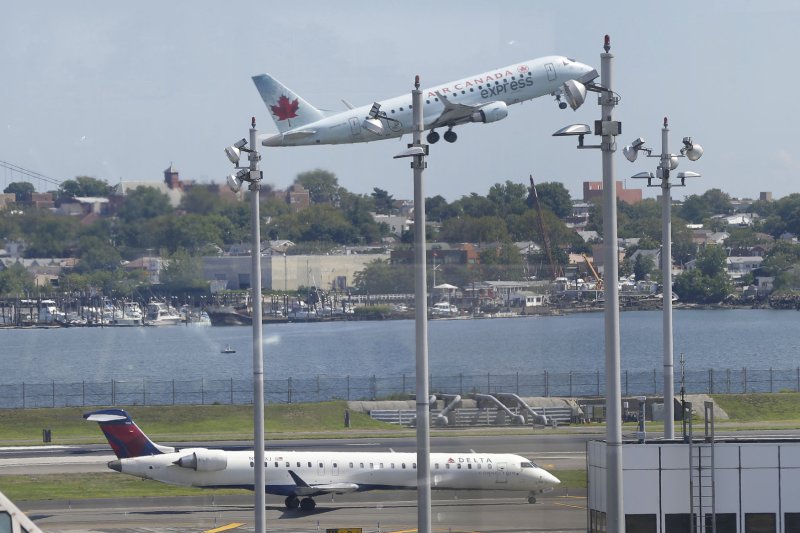An Air Canada plane takes off over a Delta Airlines plane that remains on the runway at LaGuardia Airport in New York City on August 8, 2016. Photo by John Angelillo/UPI |
License Photo
Aug. 16 (UPI) -- More efficient flight patterns can pose serious health concerns to the nearby communities because of increased noise, according to a study of LaGuardia Airport in New York.
Researchers at Columbia University's Mailman School of Public Health and Queens Quiet Skies, an organization fighting airport noise in the region, studied flights flown over Flushing Meadows and the U.S. Tennis Center in Queens -- known as the TNNIS route. The findings were published Wednesday in the International Journal of Environmental Research and Public Health.
In 2012, the "TNNIS Climb'" was implemented as a result of flight automation in New York City. Despite the change, no environmental assessment or environmental impact statement was performed on the route, researchers say. The TNNIS climb increased airplane noise to above 60dB over some of the most densely populated areas.
"There are other airports that produce more noise than LaGuardia," Dr. Peter Muenning, a professor of of Health Policy and Management at the Mailman School, told UPI. "The airplanes at LGA are smaller than long-haul flight airports and therefore produce less noise. However, the population around LGA is unusually dense, so the total number of people exposed is much higher than in most airports."
TNNIS is a route over homes that never expected airplane noise, he said.
"One departure takes off right above East Elmhurst and Jackson Heights, producing noise that is loud enough that people must shout at each other in their homes," he said. "That runway is designated only for emergencies, but it is often used."
In the study, researchers compared the costs and quality-adjusted life years gained that would be associated with reverting to pre-2012 flight patterns seen prior to the year-round use of TNNIS.
"It is important to note that some populations will be exposed no matter what," he said. "But the numbers of homes is smaller and, because the airport has been there a long time, the traditional routes also fly over the homes of people who bought knowing that they were under a flight path. These families may be less sensitive to noise."
The incremental lifetime costs are $11,288 and the quality-adjusted life years was 1.13, according to the study.
The health threats include cardiovascular disease, "though there is emerging evidence of a host of other problems, including mental illness," Muenning said. "This is caused by exposure to loud, repeated noise which evokes a stress response and disturbs sleep."
Also, he said sound produces stress, which can lead to high blood pressure. "For instance, it also causes increases in cortisone, which can produce obesity and lower the immune system's ability to respond to threats," he said.
Muenning said airports have been gradually transitioning to automated flight systems.
"The best strategy is to place airports farther away from urban centers and build transportation networks," Muenning said. "The second best is to use the flight patterns that fly over greenspace, waterways and industrial areas."















